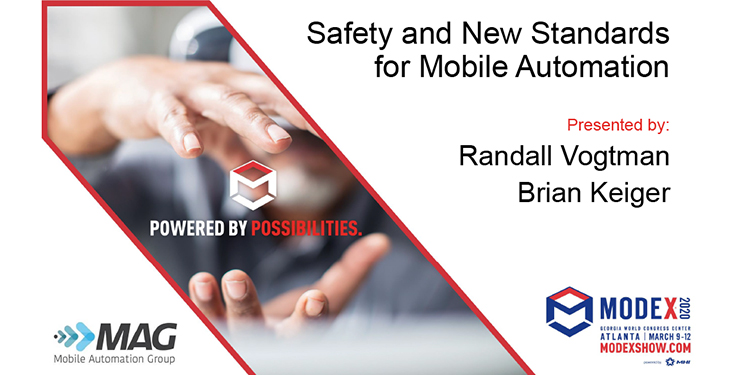Updated Safety Standards For Autonomous Vehicles Detailed In MAG’s MODEX 2020 Education Session

At MODEX 2020, held this past March in Atlanta, members of the Mobile Automation Group (MAG) of MHI presented a free, on-floor seminar to attendees. Entitled “AGV/AMR Safety and New Regulations,” the 40-minute session’s slides and audio were recorded for those who were unable to attend, or who wish to review the presentation.
The session reviews the current developments in safety standards for automatic guided vehicles (AGVs) and autonomous mobile robots (AMRs) in support or the increasing number of installations and applications of these existing and emerging technologies. For newer technologies, such as industrial mobile robots that work and interact with humans, efforts are ongoing to further define safety protocols for the proper application of risk reduction measures that ensure a safe working environment for employees. Simultaneously, the current standards for AGVs are also being updated to reflect changes in the technologies and their safe use.
Published by the Industrial Truck Standards Development Foundation (ITSDF), the newly released revision to the existing ANSI/ITSDF B56.5-2019 Safety Standard for Driverless, Automatic Guided Industrial Vehicles and Automated Functions of Manned Industrial Vehicles includes the following changes:
- The standard no longer applies to vehicles operating in closed areas where personnel are not allowed and appropriate interlocking systems, safeguards, and procedures are in place.
- Multiple revisions define minimal clearances between the vehicle and walls, object detection, and zone classifications. These include updates to details regarding hazard zones (areas with inadequate guidepath clearance), restricted areas (areas with inadequate guidepath clearance and no escape route that cannot be protected by object detection devices), and very narrow aisle restricted areas (areas with less than 0.5 meters of clearance where unauthorized personnel are not allowed to enter). The standard also explains where and how to mark these areas to enhance workplace safety.
- Additional and updated glossary terms (such as “designated area,” “guidepath clearance,” “operating modes,” “rated speeds,” “safeguarding,” “qualified person,” and more) clarify and define areas where AGVs and personnel are working.
- More information is included about object detection and vehicle non-emergency controls and devices (monitoring, stop switches, and manual controls).
Underwriters Laboratory is developing UL 3100 Outline of Investigation for Automated Guided Vehicles (AGVs), a certification that applies to industrial truck AGVs, load bearing service AGVs, and non-load bearing service AGVs used in indoor commercial applications. This safety standard focuses on the electrical system, including rechargeable batteries and charging systems. Its requirements specify a holistic system approach to evaluation, testing and certification. The intent is to ensure batteries, chargers and end products are protected against electric shock and fire. Among the stipulations are evaluation and tests to verify enclosure strength, safety requirements, motor safety, injury protection, performance, and autonomous functions.
The International Organization for Standardization has released ISO 3691-4:2020 Industrial Trucks — Safety Requirements and Verification — Part 4: Driverless Industrial Trucks and Their Systems. This standard covers all significant hazard and hazardous situations or events throughout the vehicle’s lifespan during reasonable and intended use.
Finally, the Robotics Industries Association is working to develop RIA R15.08, a new standard for mobile robot and AMR safety.
As a whole, the standards tend to either address AGVs or AMRs, but without significant overlap or congruence at this time. Therefore, when determining which standard should be referred to when considering an AMR or AGV system, the panelists suggest considering the size of the vehicle and the degree of damage that it could potentially do to an individual when operating at full speed. They also recommend inquiring with the supplier to understand their safety systems and best practices in the safe deployment and operation of AGVs and AMRs.
Want to learn more about safe practices in the use of AMRs and AGVs? MAG offers a variety of information and resources, here.



